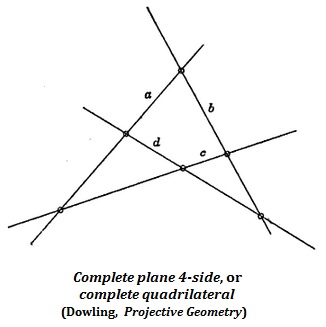A Nested Sequence of Complete N-points and Their Sections
The complete space 6-point
(6 points in general position in space,
5 lines on each point, and 15 lines, 2 points on each)
has as a section
the large Desargues configuration
(15 points, 4 lines on each, and 20 lines, 3 points on each).
(Veblen and Young, Vol. 1, exercise 11, p. 53)
The large Desargues configuration may in turn be viewed as
the complete space 5-point
(5 points, 4 lines on each, and 10 lines, 2 points on each)
together with its section
the Desargues configuration
(10 points, 3 lines on each, and 10 lines, 3 points on each).
(Veblen and Young, Vol. I, pages 40-42)

The Desargues configuration may in turn be viewed as
the complete space 4-point (tetrahedron)
(4 points, 3 lines on each, and 6 lines, 2 points on each)
together with its section
the complete (plane) 4-side (complete quadrilateral)
(6 points, 2 lines on each, and 4 lines, 3 points on each).

The complete quadrilateral may in turn be viewed as
the complete 3-point (triangle)
(3 points, 2 lines on each, and 3 lines, 2 points on each)
together with its section
the three-point line
(3 points, 1 line on each, and 1 line, 3 points on the line).
The three-point line may in turn be viewed as
the complete 2-point
(2 points, 1 line on each, and 1 line with 2 points on the line)
together with its section
the complete 1-point
(1 point and 0 lines).
Update of May 1: For related material, see the exercises at the end of Ch. II
in Veblen and Young's Projective Geometry, Vol. I (Ginn, 1910). For instance:
